This was published 8 years ago
Charter boat hire Gippsland lakes: The perfect place to hit the water on your own
By Andrew Bock
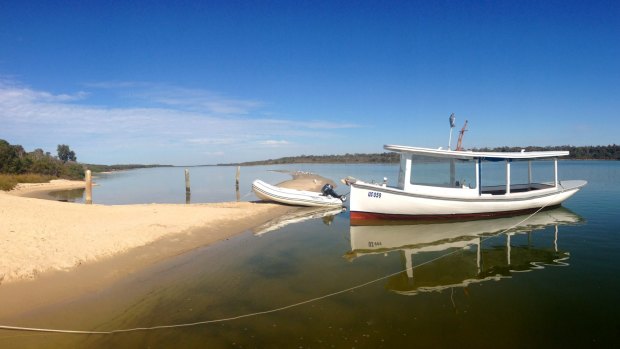
Bunga Arm beach overnight mooring.
Every kind of waterbird can be found on the Gippsland Lakes. Egrets, terns, swans, ibises, pelicans, ducks and teals. Every kind of waterbird and every kind of boat. Putt-putt and speedboat, cruiser and yacht. And they are all attracted to the same thing.
Mountains of water, from the flanks of the Great Dividing Range, form six great rivers that fill the lakes, straits, inlets and wetlands.
For millennia, the Latrobe, Thomson, Avon, Mitchell, Nicholson and Tambo rivers have pushed the Tasman Sea back behind sand dunes that form Ninety Mile Beach, one of the longest beaches in the world.
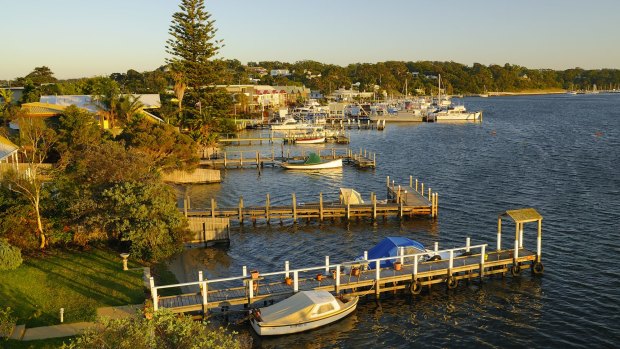
Lakeside, Metung.
Victorians named the rivers and lakes after politicians and explorers but local Aboriginal people named them after waterbirds and elements of nature.
In Gunaikurnai, according to Indigenous language worker Doris Paton, the Wirnwirndook (the song of a bird) flows into Durtyowan then Lake Murla. The Wah-yung (a spoon-billed duck) flows into Nerran (the moon).
In English that translates as: The Macalister River flows into the Latrobe then Lake Wellington. The Mitchell flows into Lake King.
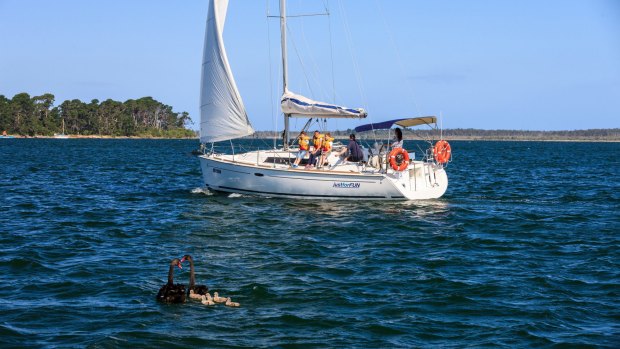
Swans and cygnets around yachtCredit: Visions of Victoria
The Gunaikurnai people believed they were descendants of Borun, an ancestral pelican, and Tuk, the musk duck.
A connection with waterbirds makes sense to anyone who visits the Gippsland Lakes. More than 20,000 waterbirds frequent the waterways, some migrating from Siberia and Alaska.
The lakes cover 340 square kilometres and form the largest navigable network of inland waterways in Australia. But unless you are a waterbird, the Gippsland Lakes are best explored with a boat.
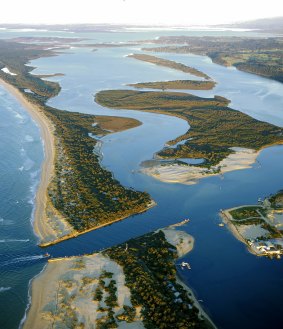
The Gippsland lakes from above.
You don't need a licence to charter a yacht, a catamaran or a motor cruiser and stay a few magical nights on the Gippsland Lakes.
The edges and bottoms of the lakes are sand and silt and very forgiving. You can moor on shore in most places and step off the boat on to your own private beach. There are no reefs or tides. There are sheltered moorings on every wind. It's a boating playground and a fantastic place for anyone who wants to charter a boat for the first time.
We chose a 34-foot, four-cabin, Seawind catamaran from Riviera Nautic, at Chinamans Creek, Metung, a beautiful natural harbour, nestled between towering gums and hilled banks.
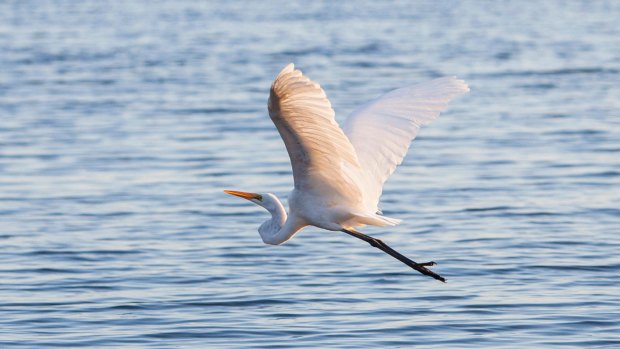
A great egret in flight.Credit: Alamy
Riviera Nautic staff provide thorough safety briefings, sailing lessons for learners and will even supply a skipper to pilot boats to overnight moorings.
It's hard to describe the joy and freedom we all felt motoring away from the harbour in our boat.
We familiarised ourselves with motor and sail in Bancroft Bay, then pulled into nearby Box's Creek, an even prettier inlet, and nosed up onto a sheltered beach for the night. We tied to mooring posts on shore, not far from another yacht, and opened our first bottle of wine as a red-orange sun began to kiss the tops of trees. Black swans with cygnets in tow sidled up to our boat. Birdsong filled the air – the whistle-whip of bellbirds and the cordial warble of magpies. A pelican landed with a hop, a skip and a susurrous slide. A pair of white-breasted sea eagles kited high in the sky, one of only 100 breeding pairs estimated to live in Victoria.
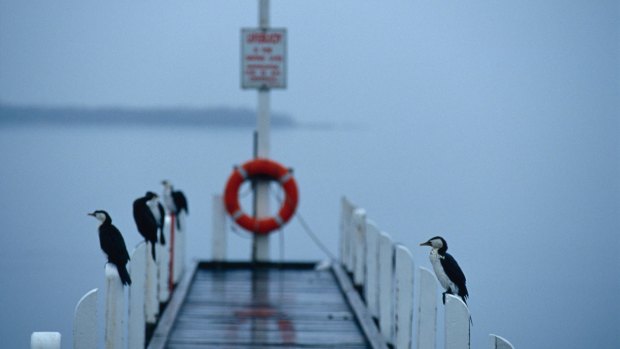
Shags and cormorants roost on jetty pylons during a rain storm.
In the morning, three native Burrunan dolphins cut gentle parabolas through the glassy surface. An antique motor boat that looked like a miniature tug boat from a children's picture book putt-putted up the creek. Quaint, old painted wooden boats were everywhere we travelled.
We sailed to Rotamah Island and the Lakes national park the following day and stayed the night on a beach in beautiful Duck Arm, a larger inlet lined with trees and paddocks. The sun on the water in the morning was intoxicating. "This is a good place for daydreaming," one of our group said dreamily, sunbaking above the swimming platform that turned the inlet into our private pool.
The next day we stopped at Paynesville for fresh oysters, extra wine, beer and ice (it is remarkable how good beer tastes on a boat). In the afternoon, we sailed, under the lightness of canvas, with nothing but the sound of water, across Lake King to explore the mouth of the Tambo River.
A kilometre upstream we found a sheltered bank and dived overboard for a swim in the sweet water. Before trains and highways, steam boats like the 1877 paddle steamer the Tanjil ferried animals, produce and passengers down the rivers and across the lakes, sometimes to ships that sailed to Melbourne and Sydney. We could have motored another 40 minutes up the Tambo and stayed at a jetty near the Swan Reach Hotel, one of several pubs accessible by boat on the lakes, but we wanted wilder nature. The luxury of a boat is the ability to change the scenery whenever you want. A boat on the lakes is a room with 1000 views.
We sailed to Bunga Arm, past Steamer Landing, and on to Ocean Grange, an extraordinary enclave of houses nestled in the dunes between the lakes and the ocean, and accessible only by boat.
As we approached Ocean Grange through a maze of channel markers we rounded a sand island that is home to a pelican rookery and hundreds of pelicans took flight.
We tied up to the jetty then walked through shady ti-tree over the dunes to Ninety Mile Beach. Sunset filled the sky with the same pastel mauves and creamy golds found on the inside of cockles that wash up on this beach that stretches to forever. The sky is vast.
The next morning, we met a woman who had taken her children to school by boat every day. "It gets more beautiful the further east you go," observed another local, and we had to agree.
The following night, a storm arrived early and woke us to the most spectacular show on earth. Thunder clapped as hydras of lightning lit up the lakes around us.
On our last day, a gentle mist settled over the water, cormorants raised their wings in salute on faded aqua channel markers, and our boat felt so cosy, we didn't ever want to go home.
TRIP NOTES
MORE INFORMATION
GETTING THERE
Riviera Nautic is at Chinamans Creek, Metung, 3½ hours drive from Melbourne or nine hours from Sydney.
CRUISING THERE
Riviera Nautic charters a range of day boats, motor cruisers and yachts. Yachts suitable for up to six people start from $241 a day and motor cruisers, for up to eight people, start from $287 a day (for seven days off peak). Three days on the catamaran, for up to eight people, starts from $1444. Prices include fuel and boat briefing. The best months on the lakes are October to April but winter and autumn are also beautiful with more sunny days and gentle north-west winds. See rivieranautic.com.au.
WHAT TO BRING
Bring waterproof gear, light-soled sandshoes, a torch and fishing gear if you want to fish. Stock up on provisions in Bairnsdale, or buy them from the boat at Paynesville or Metung. Paynesville Seafoods is great for fresh fish. Hotels with good restaurants accessible by boat are at Loch Sport, Swan Reach, Paynesville and Metung.
Andrew Bock was a guest of Riviera Nautic.
Sign up for the Traveller Deals newsletter
Get exclusive travel deals delivered straight to your inbox. Sign up now.